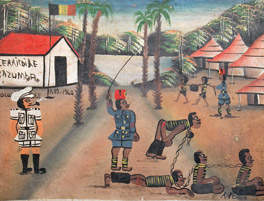BOULA MATARI
 Kapenda KapendaColonie belge, Lubumbashi, RDC. 2002Oil on canvas. Coll. RMCA |
The Kikongo Boula Matari or Boula Matadi is the name today's Congolese have given to the state. Literally, it means 'stone crusher' – in other words, 'he who goes through everything, who crushes everything in his path'. It's an old expression that referred originally to Stanley, then to the colonial authority, its agents and, by extension, statuettes of colonists. Boula Matari inspires simultaneously fear – of this all-powerful state imposing itself on the people without representing them – and the mix of admiration and envy that power has always aroused. Accession to power involves the reappropriation of symbols. The day before independence, Ambroise Boïmbo steals King Baudouin's sword: in doing so, he snatches 'sovereignty' from the Belgians and returns it to the Congolese. Well before independence, ABAKO followers consider Kasavubu 'King Kasa', the successor to King Baudouin. In the weeks following the signing of the independence act, Kasavubu dresses exactly like King Baudouin did on 30 June 1960; the sword at his side recalls that of the King of the Belgians as much as it does the swords of Kongo kings. Chain and 'chicotte'In the most negative sense, Boula Matari is associated with state violence exercised by proxy through Congolese assistants. They are the ones who inflict violence on the population on the order of European or Congolese state agents. While the 'chicotte' – a leather whip – is a precolonial disciplinary tool, Congolese associate its use with colonization, from Leopold II to the end of the colonial period. Abolished after independence, its use is reinstated by Mobutu. During the Mobutu years the prevalence of the chicotte as a subject of a series of popular paintings entitled Belgian Colony can be seen as a criticism of his regime as much as of the colonial regime. Another theme inspires Congolese artists: images of chained prisoners, which evoke the slave trade. In this way, the Congolese imagination establishes continuity between the slave trade, King Leopold II's colonization, Belgian colonization and Mobutu's dictatorship. |


